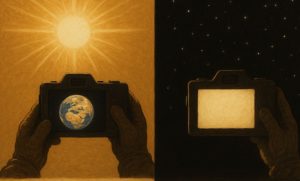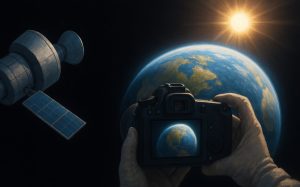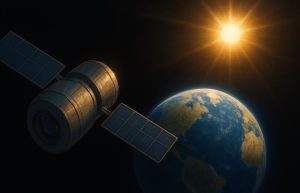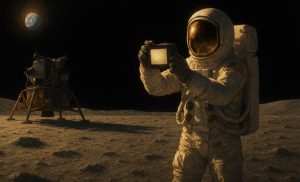Why Can’t You See Stars in Space, But Can on Earth?
You’ve likely seen breathtaking photos from space, Earth’s curve, the Moon’s surface, astronauts floating weightlessly, but where are the stars? It’s a question that puzzles many if space is full of stars, why don’t we see them in space images?
The answer lies in a fascinating combination of physics, technology, and human perception. On Earth, stars sparkle against a dark sky. Yet, in the vacuum of space, they seem to vanish from view.
This article explains why the cosmos looks so empty in photos, how the conditions in space affect visibility, and whether astronauts can actually see stars when they’re orbiting above us.
What Makes Stars So Clearly Visible from Earth?

From the ground, the stars can feel like nature’s most consistent and awe inspiring spectacle. They become visible once the sun sets and darkness envelopes the sky.
On Earth, starlight enters our atmosphere and is scattered slightly, creating the twinkling effect we associate with clear night skies.
Factors Contribute to their Clarity from Earth
- Our eyes adjust to the lower light levels at night, enhancing sensitivity to fainter light sources.
- The contrast between the dark night sky and the pinpoint brightness of stars allows them to stand out.
- Atmospheric filtering removes some daylight brightness, making the night sky more accommodating to faint objects.
In dark rural areas far from city lights, stargazers are treated to views of thousands of stars.
This visibility is due to the perfect blend of distance from artificial light, clear skies, and the unique way our atmosphere interacts with light from the cosmos.
How Does Earth’s Atmosphere Help You See Stars?
Surprisingly, Earth’s atmosphere, often blamed for light pollution and blurry telescope images—actually helps make stars more visible to the human eye.
The atmosphere filters and scatters sunlight, especially during dawn and dusk, allowing the sky to darken gradually and giving our eyes time to adapt.
More importantly, the atmosphere provides contrast. In space, without atmospheric scattering, the sky is pitch black, but here on Earth, the atmosphere adds subtle gradations of light and shadow. These contrasts allow our eyes to better distinguish faint celestial objects.
Furthermore, when looking up at stars from Earth, you benefit from the way our atmosphere bends and spreads starlight slightly. This causes the stars to twinkle and draws attention to them against the stillness of the sky.
In essence, the very layer that distorts our telescopic view actually enhances our natural, unaided ability to see stars from the surface of our planet.
Why is the Night Sky on Earth Filled with Stars, but Not in Space Photos?

This contrast between stargazing from Earth and the apparent starlessness of space photos boils down to technical and environmental differences:
The Key Differences
- Camera Settings: Cameras aboard spacecraft are usually set to expose for bright, nearby objects like Earth or the Moon. These exposure times are too short to pick up faint starlight.
- Bright Backgrounds: Surfaces like the Moon or Earth reflect intense sunlight, overwhelming the dim light of distant stars.
- No Atmosphere in Space: The lack of atmospheric scattering in space creates a stark black background. While it seems perfect for star visibility, it actually reduces contrast against bright objects.
- Dynamic Range Limitations: Cameras can’t capture extremely bright and dim light in a single frame.
On Earth, our eyes adjust to darkness, and with minimal light pollution, stars shine brightly. In contrast, in space photos, you’re usually seeing scenes captured during full sunlight on reflective surfaces. It’s the visual equivalent of trying to spot a candle’s glow while staring at a floodlight.
So while the stars are there, both in space and on Earth, it’s the conditions and equipment that determine whether or not they’re visible to us.
Can Astronauts Actually See Stars When They’re in Space?
Yes, astronauts can see stars from space, but it depends entirely on their environment and lighting conditions.
When in the shadow of the Earth or the Moon, and away from direct sunlight, astronauts report seeing a dense blanket of stars unlike anything observable from Earth.
The absence of atmospheric interference allows for a stunning, uninterrupted view of space. However, when astronauts are in sunlight, their eyes adapt similarly to how ours do during the day.
The extreme brightness of nearby objects, like Earth, the Moon, or the spacecraft, reduces their ability to see the faint light of stars. It’s not that the stars disappear, but rather, they are drowned out by the brightness.
Astronauts often need to move into darker areas or shield their view from the sun to fully experience the starlit universe. This contrast explains the seemingly contradictory reports about star visibility in space.
Why Can’t You See Stars in Space?
The question “Why can’t you see stars in space?” is best answered by examining the interaction between light, technology, and perception.
Contrary to popular belief, stars are indeed visible in space, but they often don’t show up in photos or under certain conditions. Here’s why:
1. Bright Surfaces Overpower Faint Stars

When cameras capture images of the Earth, Moon, or spacecraft, they focus on bright, reflective surfaces.
The sunlight bouncing off these surfaces is so intense that it outshines the faint starlight in the background, making stars nearly invisible.
This is similar to how you can’t see stars in the daytime on Earth because of the Sun’s brightness.
2. Camera Exposure Settings

Cameras in space are usually set to capture well-lit objects, such as planets or spacecraft, using short exposure times.
These settings are ideal for bright objects but don’t allow enough light from stars to be captured. If cameras used long exposure times, stars would be visible, but the main subject of the image would be overexposed.
3. Limited Dynamic Range of Cameras

Cameras have a restricted dynamic range, meaning they can’t simultaneously capture both very bright and very faint objects in a single shot.
If an image is adjusted for the bright lunar surface or space station, the faint light of stars gets lost.
4. No Atmospheric Scattering

On Earth, atmospheric scattering spreads light, creating a blue sky during the day and allowing stars to twinkle at night.
In space, the absence of an atmosphere means the sky remains black, but this doesn’t make stars any brighter. They remain faint against the overwhelming brightness of nearby light sources.
5. Astronauts’ Eyes Adjust to Brightness

Just like human eyes adjust when stepping into a bright environment, astronauts’ eyes adapt to the intense sunlight in space.
When looking at well-lit objects, their pupils contract, making it difficult to see faint stars, just as it’s hard to see stars from a well-lit city at night.
Stars Are Visible in Space, Just Not in Most Images
While stars often don’t appear in space photographs, they are still visible to astronauts in the right conditions.
When astronauts are in shadowed areas, such as inside a spacecraft or on the night side of Earth, they can see stars clearly. However, most space images prioritize well-lit subjects, making stars disappear in the process.
So, while stars are present in space, a combination of technical and physiological factors means they often go unseen.
The vacuum of space does not inherently make stars more visible; in fact, the harsh lighting and lack of scattering contribute to their apparent absence. It’s all about perspective and sensitivity, both human and mechanical.
Why Don’t Stars Appear in Photos Taken From Space?

Photos from space are often taken in environments flooded with sunlight—reflecting off surfaces like the Earth or Moon.
Cameras are adjusted to capture these brightly lit scenes. To do this, they use very short exposure times that don’t allow enough light from stars to be gathered.
This is a common limitation in photography. When you try to take a picture during the day of something bright, the camera must adjust to prevent overexposure.
The same applies in space. Because stars emit significantly less light than the Earth or Moon, they get “washed out” in these photos.
Additionally, cameras have limited dynamic range. This means they can’t capture extremely bright and dim details in a single frame.
To photograph stars in space effectively, special long-exposure photography is required, something not often prioritised during space missions, where the focus is on planets, hardware, or astronauts.
How Do Camera Exposure Settings Affect Star Visibility in Space?
Camera settings are one of the most important reasons why stars don’t show up in space images. Capturing stars requires a specific set of adjustments that space photography often doesn’t employ.
How Exposure Impacts Star Visibility?
- Shutter Speed: Stars are faint. To capture them, cameras need longer shutter speeds. But when imaging bright objects like Earth or the Moon, a long exposure would overexpose the image.
- Aperture: A wide aperture helps let in more light, but again, it risks blowing out nearby bright areas.
- ISO Settings: Higher ISO increases light sensitivity, but can also introduce noise, especially when bright elements are already in the frame.
When cameras on spacecraft are configured to photograph well-lit objects, they are optimised for speed and clarity, not depth and low-light detail.
That’s why, unless a photo is intentionally taken to reveal stars using long exposure, they simply don’t appear.
This is the same principle behind Earth-based astrophotography. To see stars clearly, photographers often take pictures over several seconds, or even minutes, to allow faint light to accumulate on the sensor. Space photos just aren’t taken with that intention in most cases.
What Role Does Sunlight and Spacecraft Positioning Play in Blocking Stars?

The positioning of spacecraft and the presence of sunlight are key reasons why stars are invisible in many space images.
This phenomenon isn’t due to an absence of stars, but the overwhelming brightness of nearby sources.
Why Are Stars Not Visible in Many Space Images?
- Direct Sunlight: In space, sunlight isn’t diffused by the atmosphere. It’s intense and direct. Any surface illuminated by it appears extremely bright to both the eye and camera.
- Reflective Surfaces: The surfaces of spacecraft, space suits, or planets like the Moon reflect vast amounts of sunlight, increasing contrast against the black background.
- Spacecraft Orientation: When spacecraft or astronauts are positioned with sunlight in the frame or behind them, the brightness overwhelms the faint starlight.
As a result, cameras must be configured for high-brightness scenes, using short exposure settings that simply can’t pick up stars. This creates the illusion of a starless sky.
To actually see stars, spacecraft or astronauts need to face away from sunlight or enter a shadowed region.
So, while stars are always present, their visibility is all about positioning, exposure, and the direction of the light source.
Is Space Really Dark, or Are Our Eyes Just Not Used to It?
Space is indeed dark, but it’s not empty or devoid of light. The perception of darkness in space stems from how our eyes adjust to different light levels and the absence of atmospheric scattering.
On Earth, even the darkest nights have some light pollution or atmospheric glow. In space, without an atmosphere, there’s no blue sky, no diffusion, only direct light and shadow.
When you’re exposed to direct sunlight in space, your eyes adjust similarly to being outside on a sunny day. This adaptation reduces your ability to see fainter objects like stars.
Only in darker conditions, such as the shaded side of Earth or the far side of the Moon, do astronauts begin to see the cosmos clearly.
So, space isn’t dark in the absence of light. It’s dark in appearance due to a combination of optical adjustment and the extreme contrast between bright and faint light sources in a vacuum.
Does the Moon Landing Prove Stars Can’t Be Seen from Space?

The Apollo Moon landing photos famously lack stars, which has led to conspiracy theories. In reality, the missing stars are a direct result of camera exposure settings.
The surface of the Moon, lit by unfiltered sunlight, is extremely bright. To properly expose the astronauts and lunar features, NASA’s cameras had to use fast shutter speeds.
These fast exposures didn’t allow the camera sensors (or film at the time) to collect enough starlight to make stars visible.
It’s the same reason you can’t see stars during the day on Earth, our eyes adjust to the sunlit landscape, and fainter objects become invisible.
In truth, astronauts have confirmed seeing stars during their missions, especially when they moved into shaded areas or during orbital night.
The photos don’t disprove star visibility; they simply reflect the limitations of photography under extreme lighting conditions.
Could Long-exposure Photography Reveal the Stars from Space?
Absolutely. Long-exposure photography is the key to capturing stars in space. When a camera is allowed to collect light over several seconds or minutes, even the faintest celestial objects become visible. This technique is commonly used in astrophotography both on Earth and in space.
Space telescopes like Hubble or James Webb operate using long-exposure imaging to reveal galaxies, nebulae, and distant stars.
Similarly, astronauts or probes that aren’t focused on bright objects can be programmed to use longer exposures to capture stars.
However, this method isn’t typically used in routine spacecraft photography. Mission cameras are designed for clarity, speed, and data efficiency. Unless the mission explicitly involves astronomical imaging, stars are not the focus.
Still, when long-exposure techniques are used in space, the results are stunning, capturing the true grandeur of the cosmos. So yes, stars can be photographed from space, it just requires the right approach.
Conclusion
The mystery of why you can’t see stars in space images is rooted in the mechanics of photography, human vision, and environmental contrast. Stars are not absent from space, they are always there, but are easily overwhelmed by brighter sources of light.
Whether it’s the intense sunlight in orbit or the reflective surfaces of planets and spacecraft, starlight becomes virtually invisible without the right conditions or camera settings.
Astronauts can and do see stars, particularly in shadowed regions or with proper adjustment. With long-exposure photography, the universe’s brilliance can be captured in detail.
The next time you see a photo of space that looks starless, remember, it’s not what’s missing, but how we’re looking.
FAQs About Why Can’t You See Stars in Space
Why does the sky in space appear completely black?
The sky appears black in space because there is no atmosphere to scatter sunlight. Without scattering, you only see direct light and shadow.
Do space telescopes capture stars differently than human eyes?
Yes, space telescopes use long exposures and highly sensitive sensors. They can detect faint stars far beyond human visual capability.
Can light pollution affect space observations?
Light pollution doesn’t exist in space like on Earth. However, sunlight or spacecraft reflections can still interfere with visibility.
Are stars visible from the International Space Station?
Yes, stars are visible from the ISS, especially when it’s on Earth’s night side. Astronauts often report stunning views from orbit.
How do astronauts describe seeing the cosmos from space?
Astronauts describe a vivid sky filled with stars when in darkness. The view is clearer and more expansive than from Earth.
Why do we need special equipment to photograph stars in space?
Cameras need long exposures to collect enough starlight. Short exposures for bright objects don’t reveal faint stars.
Does space travel affect how light is perceived by the human eye?
Yes, your eyes adjust to brightness levels in space like they do on Earth. Bright light from the sun can reduce star visibility.







